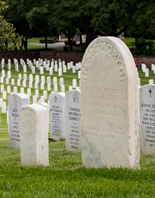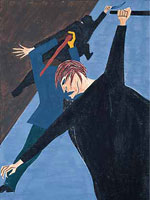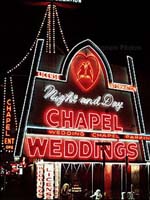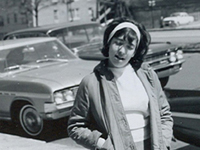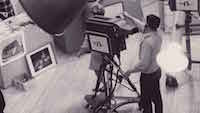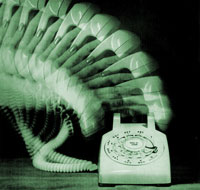A Close Look at the FDR Memorial
Historian Christopher Hamner introduces educators to the original Franklin D. Roosevelt Memorial in Washington, DC—a simple engraved block of marble. Hamner asks how this memorial, dedicated in 1965, contrasts with the 1997 memorial on the Tidal Basin. What different purposes do the two memorials serve?
Christopher Hamner: Somebody who's been to the FDR Memorial describe that one.
Teacher 1: An experience.
Christopher Hamner: Okay. What does it look like? How big is it.
Teacher 1: It's huge.
Teacher 2: It's larger than life.
Teacher 3: It's the different acts or time periods in his life.
Christopher Hamner: So how much—it covers a fairly large spread of ground. It covers different phases of his life. The centerpiece is. . . ?
Teacher 4: Him in his wheelchair.
Christopher Hamner: Yeah, exactly. He's in his wheelchair, I think he's got his dog Fala—which is always a crossword puzzle answer—F A L A, if that comes up. Why is this here if we have a perfectly good memorial over by the Tidal Basin?
Teacher 5: The money? They had extra money.
Teacher 6: This one was earlier.
Christopher Hamner: Yeah, this one's first. That's a good question, but this one is actually first. And this is the one that FDR suggested during his lifetime. He had been elected president four times; it seems more likely than not that he might someday get a memorial. When asked what would be an appropriate way to commemorate his life as a public servant, I believe he was in the Oval Office, and he said a block of marble the size of this desktop with my name and my birth date and placed at the National Archives. He thought that—which I think is very understated, he picked the location, he picked the design, and that's exactly what you've got. The FDR Memorial at the Tidal Basin is totally different—in so much as he told us exactly what he wanted, it kind of flies in the face of his wishes and his explicit instructions.
There's a further twist there and if you remember back to the second week when Michael O'Malley came in and talked about political theater. The centerpiece of the memorial at the Tidal Basin is FDR in his wheelchair. For a president who went to such enormous lengths over the course of his entire political career to never be photographed in his wheelchair. Remember Professor O'Malley talking about how he would set up rails so he could appear to walk to the podium, so that he could carry himself to the podium, he had a car outfitted with hand controls. This is not just someone who did not make a big deal about the fact that he was in a wheelchair; this is someone who went to great lengths to disguise that fact.
Christopher Hamner: That’s a great point to talk about: Who is this memorial for? Is it for the person; is it for the generation for whom he was such a central figure? There's a whole generation of Americans and he guided them through the Depression and the Second World War, is the memorial for them? Is it for us, for contemporary generations who are trying to place him in a historical context? Those are really useful questions and they're transportable. You can ask these questions about any monument in any place.
Christopher Hamner: Why do we do that?
Teacher 5: We've got to teach now. The other memorial is supposed to be a teaching memorial. This I think was probably done fairly close after his death—
Christopher Hamner: I would imagine.
Teacher 5: It's not designed to teach.
Teacher 7: I know! There's a little marker right there that explains. It was put in by his friends of his to commemorate the 20th anniversary of his death in 1965.
Christopher Hamner: Is that the right thing to do? To go…when somebody says this is how I want to be commemorated and you go and say yeah, alright, we're going to do something different.
Teacher 7: It depends on who it's for. If you're doing it for that person, yes. The other memorial is not for him.
Christopher Hamner: So who is it for?
Teacher 8: Everybody else.
Christopher Hamner: Yeah, that could be a glib but accurate answer.
Teacher 5: But it's for people who didn't experience New Deal programs. At this point—I had the reality check that I am now wholly in a totally different generation than my students this year. Their great-grandparents fought in World War II versus my grandparents. And that their grandfathers fought in Vietnam whereas my father fought in Vietnam. So you've got so many people that are so far removed at this point that this isn't going to teach them about who Franklin Roosevelt was.
Christopher Hamner: Is that what a memorial is supposed to do?
Teacher 5: That's I think what the goal of the other memorial is.
Christopher Hamner: This is where you get into the sort of interesting, undefined territory of what do we want to use this space for?
Teacher 1: There's a contrast. I think that FDR was rather shortsighted when he said I want to be remembered this way. Because I do believe that there is a teaching technique, the teacher in me comes out, but those are memories. If I wasn't an American, if I was not a history teacher, if I was just walking down the road, this just looks like a gigantic tombstone for some schmoe. Therefore, there is no memory being projected and I think that you have to honor him. I love that idea—that "I was a simple man"—but I think he was being shortsighted because we will not remember him without knowing the great things that came with him.
Christopher Hamner: I think part of the power of this is exactly how understated it is. Particularly in a city where there's Logan Circle, there are huge statues, 15-foot-tall statues, of Civil War figures that people have totally forgotten. Here is someone whose place in 20th-century history is immense and there is a kind of disconnect between the immensity of his contributions and the really plain nature of this. To that extent I think it does have some power because there's so many statues around here that are so overly grandiose and kind of hit you in the face with the importance of what they're celebrating and you think, not that important, not that significant in the long run. Whereas this, if anything I think Roosevelt's reputation has been burnished by historians over the years and this is incredibly plain and understated.
Teacher 2: How would we not remember him? That's the other component of it.
Teacher 1: Time. Time kills it.
Christopher Hamner: I think about the Martin Luther King Memorial. He talked during his life a lot about how he was a part of something, that he was not the Civil Rights Movement, but that he was a part of a larger wave. I think that that was an important statement in part because it indicates his humility but also because it underlines the rightness of the Civil Rights Movement. It wasn't one person saying okay, now the country's going in this direction but a large segment of the country saying this injustice has to be corrected. I'm not sure how comfortable King would have been to be singled out with a statue of him covered with his quotes.
On the other hand, to not do something is sometimes sending as powerful a message as to do something. To have the National Mall, which celebrates Lincoln and Washington and Grant and a lot of white elite political figures, and to not have part of the Civil Rights Movement and the African American leaders who helped push it through, that's a conspicuous absence. To not put anything is kind of an interesting—that makes an interesting comment, too.
